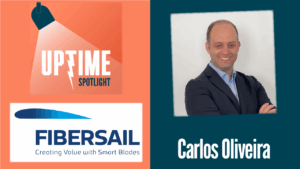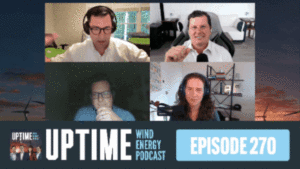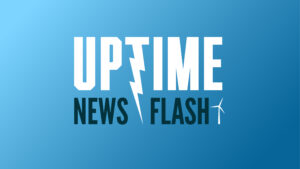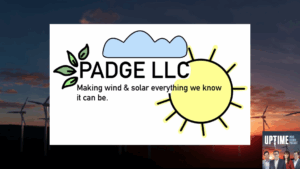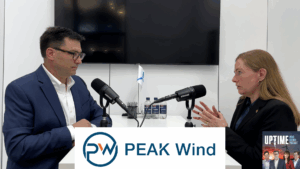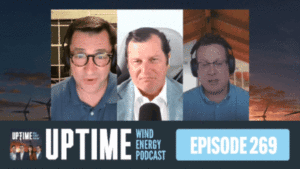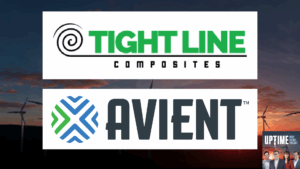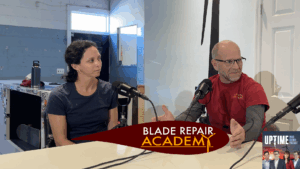Podcast: Play in new window | Download
In the Uptime Spotlight today is Stephen Bull, CEO of Vårgrønn, the company building the world’s largest offshore wind farm with a government contract: Green Volt. Stephen discusses the massive project’s progress, planning, and logistics to be completed by 2030.
Fill out our Uptime listener survey and enter to win an Uptime mug! Register for Wind Energy O&M Australia! https://www.windaustralia.com
Sign up now for Uptime Tech News, our weekly email update on all things wind technology. This episode is sponsored by Weather Guard Lightning Tech. Learn more about Weather Guard’s StrikeTape Wind Turbine LPS retrofit. Follow the show on Facebook, YouTube, Twitter, Linkedin and visit Weather Guard on the web. And subscribe to Rosemary Barnes’ YouTube channel here. Have a question we can answer on the show? Email us!
Allen Hall: Welcome to the Uptime Wind Energy Podcast Spotlight. I’m your host, Allen Hall, along with my co host, Joel Saxum today, I’m excited to welcome Stephen Bull, CEO of Vårgrønn, who is leading the charge in developing some of Europe’s most ambitious floating offshore wind projects. Stephen brings over 25 years of energy industry experience and currently oversees Vårgrønn’s Impressive portfolio of projects across Northern Europe, including Greenvolt, set to become the world’s largest floating offshore wind farm with a government contract.
Welcome to Uptime Spotlight, shining light on wind energy’s brightest innovators. This is the progress powering tomorrow.
Allen Hall: Steven, welcome to the show. Thanks so much, great to be here. Well, the Greenvolt project is one of the most important Impressive projects going on in the world right now, and you’re heavily involved with that, of course, as being the CEO of Vårgrønn and I want to understand a little bit about how that project came together and what problem Greenvolt is trying to solve.
Stephen Bull: Yeah, sure. I mean, it’s kind of neat to say it’s the most exciting project. I think it’s, uh, it’s quite a scary project in many respects for us as well when you work within the offshore wind sector at the moment, but definitely within floating offshore wind. Yeah. If we sort of dial it back down to the project itself, I mean, what we’re solving for here is, is the generic problem with offshore wind in deeper waters.
And, uh, and really when you start to push the boundaries beyond 60, you know, 60 odd plus, 70 meter water depths, you need to start to go into the floating territory. Um, and that’s something that you find distinctly within the coast of Scotland as well. There’s only so much of that seabed that is shallow and then it starts to push out there.
So, Scottish authorities, the Scottish Crown Estate, the guys who basically own the seabed license around there, want to have further developments within offshore wind, but um, they are inhibited in the sense that they have deeper waters. Um, at the same time, there’s still a quite large oil and gas industry in, of Scottish waters as there is in Norway, as well as the two largest producers in Europe.
They also have carbon issues, carbon problems of CO2 emissions from their own Scope 1 emissions. So the Scottish authorities have put together a concept which is called targeted oil and gas. And essentially they’ve been looking to lease out areas where we could develop offshore wind, both that go straight into the grid.
For the benefit of consumers, but also could help decarbonize oil and gas operations as well. So that’s the background around it. It’s happened pretty quickly. To be honest, we, we received our, uh, you know, essentially our lease just over a year ago, year and a half ago. Uh, we won a contract for difference from the UK government in September.
Uh, for 400 megawatts and we’re just basically right in the middle of procurement and developing the whole concept now so we could be online by 2030.
Allen Hall: Wow, that’s a really short timeline. There’s a lot to be done between now and then. In terms of the electricity for a minute, let me just walk through this.
Your plan, and the way it’s proposed, is there’s floating platforms with wind, there’s a HVDC line, I think is where you’re going, that will run to offshore oil and gas platforms, so it will power those oil and gas platforms, but it also runs onshore into Scotland. So, you can power oil and gas offshore, also power onshore, and then that’s sort of a bi directional feed that, in the event that the wind’s not blowing enough in Scotland, which is really important.
Pretty rare, honestly, then the power can come onshore to the oil and gas platform. So it’s sort of a redundant tool to offtake system.
Stephen Bull: Yeah, it is. So the, the, the, what underpins the project itself is, is the contract with difference. And this is the policy mechanism. The UK government has basically dialed down for, for some time.
Um, it’s, it’s a 15 year price you receive. So actually you go into an auction, you win a 15 years and basically it’s a, We received 139 per megawatt hour in 2012 prices. So that’s just shy of 200 per megawatt hour. Uh, and it’s, so it’s an inflation adjusted, uh, within that, that period. Um, and that’s great because what you can do with that one, you can use that to essentially underpin the financing of the project itself.
Um, and what we do on top of that one is that, you know, in outside of the 400 megawatts, then we have up to 560 megawatts that we could produce in the total area, uh, which can, you know, help towards oil and gas decarbonization. And it was the, you know, again, that, that has to be, that’s a direct relationship we will have with oil and gas operators with their, with the PPA.
But the idea being is that, If they obviously want to turn off their gas turbines, or if they’re using diesel, then they need 100 percent guaranteed power. Yeah.
Joel Saxum: So a question for you there then, um, you’re gonna be pseudo co located, right? You’re gonna be within, you know, within distance of these offshore oil and gas platforms, so you’re not running an export cable hundreds and hundreds of kilometers.
But what is, so how, how many of those platforms will you guys be able to feed? And what’s the actual power demand of those platforms?
Stephen Bull: It varies quite dramatically. So the area that we have, and we were in an area which is about 80 kilometers off the coast of a place called Peterhead, which is just north of Aberdeen in Scotland.
Um, there are some oil and gas installations in the area. Most of them are a bit further out. So what we did is we were awarded two licenses from Scottish authorities. One called Greenvault. Sinos is much further out. That’s, uh, that is within the HVDC territory, but it’s much closer to oil and gas operations.
And that’s actually quite close to the Norwegian border as well when it comes to, uh, the Norwegian border between the UK continental shelf and the Norwegian continental shelf. So that could be potentially an opportunity to decarbonize also outside towards Norwegian platforms as well. Um, it’s, it’s kind of, it’s, it’s when you put things in perspective, I mean, the most important thing is that this project has got a contract for difference.
We’re going to get it going. We hope we can find strong support from oil and gas who want to sign up for a PPA so that we actually can. Uh, work with them, decarbonize their, their emissions, and they’re not inconsiderable. They’re, you know, it’s between up to maybe 13 to 15 million tons of CO2 emissions come from the UK sector.
Uh, roughly about the same in terms of Norway, uh, as well. So, you know, 25 odd million tons of, of CO2 reductions is something which is quite considerable, which, which oil and gas needs to do in a, in a net zero context. So. There’s different drivers of this. Some could be complete cable from shore. Others could be that you just have don’t full, fully decarbonize, but you can reduce the amount that you use by having a gas.
Uh, turbine would also, uh, a ring fence system that you could have with offshore wind. They do that in a project in Norway already. It’s called Highwind Tampen. So it’s a, you know, an experimental project there, but it’s the largest floating offshore wind, uh, farm today, uh, in operation. So there’s, there’s different ways you can cut and slide this up, uh, in, in terms of that.
But the, the key one around it is that In many respects, you’re using oil and gas technology, for example, floating technology, deep water technology for spas or for semi submersibles, but you’re dialing it down into something which could be, you know, in a renewable context, and obviously repeatable as well.
Joel Saxum: So it’s saying that, Highwind Tampin, I think that was an Econor project, correct? That powered some offshore oil and gas platforms. But this being said now, 400 megawatt contract contract for difference permit, plus another 160 out there. So 560 total, that will put you guys in place to be the largest offshore floating wind farm in the world.
Stephen Bull: Correct? We’ll see, you know, China’s pushing things on Korea, boosting things as well. You know, so we’ll see. And then France has also threatened some 750 megawatt projects as well. I mean, the thing is that we want to see them all happening. And again, the hard bit about it, when you think of the 70 odd gigawatts of offshore wind probably commissioned today, 300 megawatts is in floating.
You know, it has anywhere near the scale and the repetition and the modularization that we need to get so we can bring the cost down. We’re all for as many projects as possible, but um, but us probably, we could probably safely say it’s the largest commercial project in Europe. A lot of people aren’t quite sure exactly what water depths that mean. What water depths are you guys in?
Joel Saxum: So we’re in about 110 meter water depths, which you know again, this sounds a bit weird, but you actually want the right kind of water depth. So you don’t want something under a hundred generally, because you have a mooring system that would be a quite cattery mooring system, which would be quite costly to have that.
That’s a lot of chain you need in there. Super deep is quite difficult, you know, so I think finding the right kind of, uh, the water depths then, and again, the site conditions are very different with all these projects as well. You know, the kind of site conditions you get off the coast of Norway or where you get off the coast of Scotland or France or Japan as well are very different.
So. In that sense, you also have to tailor make the mooring system, the floater itself, the integration of the tower, the turbine. Yeah, a lot of bespoke stuff. So we’re, we’re not on the standardization train yet.
Yeah. I had that conversation with someone the other day, we’re talking about offshore floating wind.
Who’s going to, what, you know, what technology is going to emerge as the, as the forefront, as that, as that front runner, who’s going to be the big one. And, and we got a little bit deeper into the engineering side of things. My background from offshore oil and gases. Exactly what you just said. Every water depth, every seafloor condition, every topside condition is different around the world.
So there, you’re not necessarily, you’re not necessarily going to have one type of technology that just dominates the whole market. There’s going to be specific ones. So if, if you guys are, building for, you know, specifically, you know, 80 kilometers off Peterhead up in that North Atlantic. Is there a certain kind of technologies that you guys are looking at right now in your, in your RFP for building this thing?
Or is it spars or what do you guys, where are you focused on?
Stephen Bull: We’ve dialed it down to, to a few designs already. Um, and the key thing about this is it’s generally, it’s, it’s, it’s actually water depth of the key. Uh, and when you start to do the assembly work is often some of the drivers. So. For example, the Highwind Tampon Project from Equinor, they used a spar.
And that’s a concrete spar. So it was, uh, it was a slip formed concrete spar, which is, you know, oil and gas technology. You’ve seen these in massive concrete floating foundations over time, but just, you know, much smaller. But you can do that when you’ve got water depths of, you know, a hundred plus meters right next to the quay here in Norway.
So you have some obviously deep fjords. Scotland doesn’t have that. So unless you wanted to build it out into Norway and you drag it across the, the North Sea, then that’s the other option you do. And it has been done. Harbour Scotland was built in that way as well, which, uh, which Equinor built, um, uh, you know, only about five years ago.
But what we can see for our one is, you know, we’re, we’re thinking more around the semi submersible type of space for the concept here. Again, we’re in the middle of a procurement system at the moment, so I won’t be giving away all the fun facts around that one, but again, it’s, it’s, it’s different strokes for different folks based on these, these kinds of conditions.
But I think if I was dared to bet on the technologies, the spar is great for Norway and the harsh conditions of the Norwegian continental shelf. You’ve got a, an oil and gas supply chain there that knows this business. It, it, it’s, it works. It’s good. Not to say that’s the only design there, but for, you know, Scotland, for France, for others, you’re probably going to see more of the semi submersible.
And you might see some tension like platforms. You might see some barge type solutions as well. But again, it depends very much on the bathymetry and the, you know, site conditions as well.
Joel Saxum: I think you guys have a great advantage up there of just being in an area that’s been an oil and gas hub. There’s been offshore infrastructure being built there for decades.
60 years now, so the port facilities are there, the vessels are there, the people that know how to get things done are there. Um, so that’s, that’s huge. Now, so my next question would be like, you guys get this thing into operation. Is who’s going to maintain this thing? Are you guys going to be doing all of the, the service yourself?
Are you going to build that out as a, as a capacity or we’ll, you know, we’ll go to the turbine OEMs or how are you going to operate
Stephen Bull: that? I think it’d be a hybrid of things, but we’re both with the turbine OEMs, uh, and how we would operate ourselves. So there’s different philosophies around this, as you know, you know, I’m, you know, there’s an outsourced market or third party market, isn’t it, for O and M operations, which.
Works great in mature areas. I think when you are doing this for a new technology, um, and particularly with more harsh conditions as well, you need a service operation vessel to run this, not a crew transfer vessel because of the distance from shore and also wave height as well to try and access the turbines.
So you, you know, need a different concept there. But these are things that we’ve seen already. We’ve seen it in the Dogger Bank project, which SSE and ourselves are owners in, we’ve seen it in other projects around too, but the key thing about it, and we’ll probably come on to the financing discussion is that to finance this and actually think of the, um, uh, risk management around that is that, you know, you want to have a very, very clear hands on operating concept.
So I think that that would be part of part of parcel of that. But again, when we start to think about more digital solutions and the idea is we want to be touching these turbines less. We don’t want to be out there all the time, especially in the winter months. That’s
Allen Hall: the key bit. And some of those lessons were learned from high wind Tampin, right?
Is that that was a really critical project. I know there’s been a lot of controversy about that project, uh, about the success of the project in, in the engineering world. However, that project led the way so that. Greenvolt can happen. You just, it’s continued on and on. And that happens in the financing world also, right?
That, that, the, the financing of how Equinor ran Highwind also rolls into how Greenvolt approached financing a little bit. Can you explain how this all comes together financing wise and how you’re trying to, With a new government in place and you have a new government, we have a new government, um, in the United States.
How that works together to push this project forward. I mean, you know,
Stephen Bull: there is this sort of standing on the shoulder of the giants, uh, thing going on here. And I think, um, again, I’m sort of kind of lucky enough in the sense I actually worked in both Noshkidro and in Equinor. So I’ve been involved in some of this for a personal level and, uh, of many, many hundreds or thousands of other people involved in floating offshore wind.
But. That first demo project in 2007 off the coast of, of Senga, which, uh, noro developed initially and then they came under the wings of EOR afterwards. I mean, that, that set up some fascinating DR and D work. And it was in, you know, pitch blade motion control. It was under understanding the spa, the interaction between the tower, uh, all the forces that you have at work, uh, within, you know, within these operations.
And then you came behind, um, Scotland on top of that, tampon built on the top and obviously. There’s the other Daikin Cardean has been developed, you’ve got, you know, demos that are in Portugal and, and, and other areas as well. So I think that the main thing is that to, you know, to take some of those learning and some of those projects, you know, help our project finance, but the majority haven’t been, you know, they’ve either been demos or, you know, having Tampin, you wouldn’t need to project finance.
It’s all in gas, so essentially, you know, essentially the sort of the licenses behind it. But what you do know is that we. When you do talk to banks and you discuss what’s going on here, I mean, one thing is there’s actually quite a strong appetite for banks to be involved in the project financing of floating offshore wind.
They see a lot of opportunities, particularly Japan, uh, not surprisingly, and a lot of Japanese banks are already deeply into the UK offshore wind market already as, as finances, um, and infrastructure anyway. And then what you do is you start to use references and, and essentially verification from the oil and gas industry.
So, one thing is you can, what we take, learning we can take from other projects like Kim Kardine or, or any of the, the Equinor projects. But you do use references, for example, mooring systems, suction anchors, technical integrity of steel, uh, operations and maintenance using SOV vessels, these kinds of things, stuff that’s been tested already.
You just have to contextualize it for that particular project for the lenders.
Allen Hall: And that’s a unique approach. I think bringing Japanese in makes complete sense to me. And you do see a lot of activity in Japan on floating wind. Obviously, that’s going to be where they’re going to go. So it’s a learning experience for everybody.
When you’re Building out now in, around Aberdeen, you have an office now in Aberdeen and you’re trying to grow that. How big does this become in and around Aberdeen in terms of the number of employees and the amount of funds that are gonna happen in that area? So the, I mean, the
Stephen Bull: numbers are, the gross value added, we say, total investment is about 2.
5 billion pounds. And a lot of that, so it’s, it’s, a big chunky change, no doubt about it. them. And then it’s around about 2, 800 people we’ve measured up there with jobs during construction. And obviously you have, you know, you’ll have probably 40 to 60 working operations and maintenance or office work to, you know, essentially go into office mode.
Um, we know, I mean, literally three weeks after we were awarded our contract, the difference of the government, we announced that we’re putting our office in, uh, in Aberdeen. So we’ll build on the office there with our partners, Flotation Energy. Um, and again, we, you know, we’re building a lot of from competence, from, you know, pure offshore wind background, but also many from the oil and gas sector as well, uh, including myself from that type of background.
So there’s, you know, there’s a great investment there, but the key one around this one is that when it comes to port infrastructure, when it comes to grid connections, all the rest of it in more remote areas, like the Northeast of the United Kingdom, is that this project does actually open up grid new investments.
And then they say, it’s not one port. Or yard that can fix this. You know, we’re talking about 35 plus floaters. They’re the size of a football field. Each of them were a football stadium, essentially. Um, you know, there’s a logistics play going on here is that, you know, we need to crack the code for this so that others can jump on the back of it as well.
And again, there’s a, there’s a whole wall of new investments and potential projects in something called ScotWind, which was a very large leasing process in Scotland, a lot of mix there between floating and fixed bottom. Um, But to, to have those investments in the ports and infrastructure that have, you know, previously oil and gas means that they can start taking those investments.
We can be part of an anchor investment there for them and then we can bring it on for others as well. You know, we hope that that drives investments, not just in jobs and skills, but also reduce down the cost of energy as well, and actually make it more competitive
Allen Hall: too. Right. That gives Scotland and the UK a huge advantage going forward, because there will be competition from France in particular.
Yes. So that’s going to be an impressive amount of effort. So what does your schedule look like now? And as a CEO, we’re going to need you. It must be schedules all the time. What happens over the next year or so? What, what, what’s the plans here? I know you have a lot of RFPs out there. What does the next year look like?
Stephen Bull: So we’re just, you know, again, working with the long lead items at the moment, which is offshore transmission. It’s the turbines in particular. That’s, that’s brick and mortar packages we’re working with at the moment. Um, and then we’d really, we’re looking at probably signing some pretty heavy contracts through 2025.
And then the FID will be taking 26. Bruce. And then the idea that would be, uh, you know, we hope first, first wind production by the end of 29. Again, but it’s actually, you’re on the clock when it comes to delivery in terms of the contract for difference. Um, you can do that. There’s, there’s some guardrails around how you can work with that one, but.
You know, you guys, you follow this up all the time. It’s a tough market in terms of the supply chain, availability, floating’s different and needs a little bit more bespoke engineering around it. It’s not off the shelf technology, a lot of infrastructure that needs to be invested in the UK to make this work.
So I think, uh, again, it’s, it’s a tough one, but I mean, that’s the exciting, this is why we do it, isn’t it? Because it is so motivating and exciting to work with these kinds of projects.
Joel Saxum: I think that what you guys are doing right now, that like the, first off, Allen and I kind of talking off air, the hedge between the two.
delivering power to the oil and gas platforms and shore. I mean, that’s, uh, innovation that makes things like this happen. That’s fantastic. But you’re doing a lot of, uh, there’s a lot of new, right? This is like, uh, we, we, you know, in the investment world, we call it folk, you know, first of a kind, but the whole project is like that, right?
So it’s, there’s kind of a lot of first of its kind things. How do you handle that role of leadership as you guys move forward in the industry?
Stephen Bull: No, it’s, it’s an interesting question, Joel. I think, um, Again, the background, I think, again, someone’s worked in oil and gas. Oil and gas is pretty good at sharing ideas and working together in terms of partnerships.
Offshore wind has been less good at that. It’s been a bit more secretive around how they, you know, how they feel that things are technically sensitive, commercially, R& D. I think for us, you know, we have to be a bit open here completely. Again, it’s if we want this to succeed for others as well. Um, then we know we have to, we have to play, play openly with others.
So I think we’re actually looking into some of that, how we actually think of the data sharing that we can use here as well. I mean, our team are out there, you know, conferences all over explaining a lot about how we’re thinking about working. We need suppliers, what we think in terms of actually infrastructure investments.
And when, when we start signing contracts for, for, for some of the major engineering packages, I mean, Others will be looking at it and thinking, okay, you know, what can I learn from this? And hopefully the smartest people will be the ones that look at it and actually don’t make the mistakes that we maybe end up or will be doing.
We know that happens in projects. Although they can start to think, how do we standardize? How do we reduce weight? How do we reduce costs? How do we bring uptime further? So, you know, there’s so many benefits that I think to, to build on this one. And, but I think, you know, you’re right. We, we have a responsibility, you know, both for not just to provide the right type of content for the UK as well for investment so that the UK can reach its floating offshore wind targets.
But, you know, again, this goes for a bit of the rest of the industry. And when you, you know, again, worked in this industry for quite a long time, but definitely the last few years have been pretty tough and a bit depressing in terms of headlines. And people say just, you know, you know, fantastic news. Love it that you guys won Greenville, you know, and it’s literally don’t screw it up.
So you feel that there, you know, they’re kind of staring over your shoulder, you know, to, to not make that mistake. But yet again, we, we, we, we take that fully on ourselves. And I think that goes for a stakeholder relationship between Scotland, the UK, local authorities as well. You know, you’ve got to play
Allen Hall: really well with everybody.
As far as hiring right now, it seems like you’re going to need a bunch of people to show up in Aberdeen. What’s the plan there?
Stephen Bull: Yeah, we are, we’re hiring pretty heavily. So we’re, we’re spamming LinkedIn with all our new positions out there. Yeah. Um, so some within our company, some, uh, our partner Flotation Energy are bringing in and then we’re bringing people directly in for the, for the Greenbelt project itself.
So definitely we’re hiring a lot. And also we, you know, our model is that we’re not going to be doing everything in house. You know, we have an outsourced model, we have a domain expertise within certain packages, and then we will be using engineering houses to work through those. So that’s, you know, Admittedly, we’re driving quite a lot of the volume within, uh, engineering consultancy at the moment, uh, across the, across the, across Europe.
Allen Hall: If you’re interested in working with Stephen at Vårgrønn, or even some of the suppliers going to be around in Aberdeen, you need to go check out Stephen’s website. Stephen, you want to give all the addresses of where they can find Vårgrønn?
Stephen Bull: Yeah, definitely. So it’s just vagron. com, uh, go in there, or if you just Google GreenVault as well, and you find that we have a supply chain, uh, So, I mean, literally, you’ll, you’ll see us all over.
We, we kind of spam as much social media as we can for a company like ourselves. But And then we’re out there also talking about these great to do this with you guys as well and tell about the project, but we’re definitely telling more about it as we as we develop it.
Allen Hall: Absolutely. It’s a wonderful project.
I know you have a lot on your plate at the moment and the best of luck to you. I’d like to have you back on the podcast to talk about how things are going in a few months because I think we’ll hear some more details coming out soon. So, Stephen, thank you so much for being on the podcast. It’s been a pleasure.
Stephen Bull: Thanks so much, Allen. Thanks, Joel.




